Urban Wildlife: Nature’s Tree Care Experts in 2024
Introduction
Did you know that squirrels plant thousands of trees every year without even trying? These bushy-tailed gardeners are just one example of how urban wildlife secretly cares for our city trees. A study by the Urban Ecology Institute found that areas with diverse wildlife populations have 30 percent healthier tree canopies. From birds to bees and even some unexpected critters, the animals in our cities are the unsung heroes of urban forestry.
Urban wildlife contributes to tree care through seed dispersal, natural pest control, pollination, and nutrient cycling. As we explore the fascinating world where wildlife meets tree care, we’ll discover how these tiny landscapers are shaping our urban jungles and why their contributions are vital for the future of our cities.
The Secret Life of Urban Wildlife in Tree Ecosystems
Our city trees are teeming with life, hosting a diverse array of wildlife that contributes to their care and maintenance. Understanding this hidden ecosystem is crucial for appreciating the role of urban wildlife in tree care.
Common Urban Tree Dwellers

A Tree Frog Rests on a Branch – Photo by Pixabay
Birds
From sparrows to woodpeckers, birds are among the most visible tree caretakers. They nest in branches, feed on insects, and help disperse seeds. Some species, like woodpeckers, even create homes for other animals through their foraging activities. The presence of diverse bird species is often an indicator of a healthy urban forest.
Mammals
Squirrels, raccoons, and even bats call our urban trees home. While some may view them as pests, these mammals play important roles in seed dispersal and pest control. For example, flying squirrels, though less commonly seen, are excellent seed dispersers and can help maintain genetic diversity in tree populations.
Insects
Bees, butterflies, and countless other insects play vital roles in tree ecosystems. They pollinate flowers, break down dead organic matter, and serve as a food source for other wildlife. Even some insects considered to be pests, like ants, can benefit trees by aerating soil and distributing seeds.
Reptiles and Amphibians
Lizards, tree frogs, and other small creatures also contribute to tree health. They often feed on insects that might otherwise damage trees, and they help maintain the delicate balance of the urban ecosystem. For instance, geckos in warmer urban areas can consume large quantities of moths and other night-flying insects that might otherwise damage trees.
Seasonal Tree-Wildlife Interactions
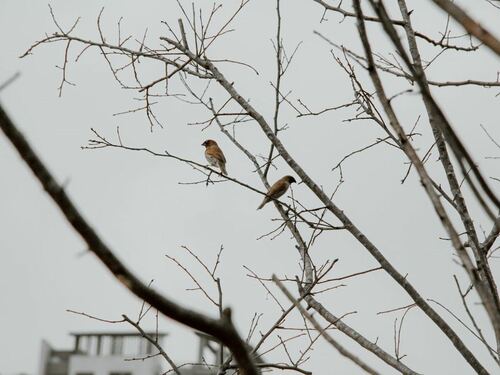
Birds Perched on Bare Winter Trees – Photo by Leo Zhao
Urban wildlife interacts with trees differently throughout the year, providing year-round support for tree health and growth:
Spring
As trees bloom and grow new leaves, animals help with pollination and pest control. Bees and butterflies become more active, while birds return from migration to nest and feed on emerging insects. This is a critical time for trees, and the presence of diverse wildlife can significantly boost their reproductive success.
Summer
Wildlife seeks shelter in tree canopies to protect themselves from extreme heat. The shade provided by dense foliage creates a cooler microclimate that benefits both animals and the trees themselves. Animals like squirrels and birds may also help prune trees by breaking off dead or weak branches during their activities.
Fall
Many species assist in seed dispersal as trees prepare for winter. Squirrels and jays cache seeds and nuts, often forgetting some, which may sprout into new trees. This natural planting process is crucial for forest regeneration and helps trees colonize new areas in urban environments.
Winter
Some animals use trees for shelter during the cold months, while others rely on them for scarce food sources. Woodpeckers and other insectivores help control overwintering pests that might otherwise damage trees. The activity of wildlife in winter can also help break up snow and ice accumulation on branches, reducing the risk of damage from winter storms.
Nature’s Gardeners: How Wildlife Contributes to Tree Planting
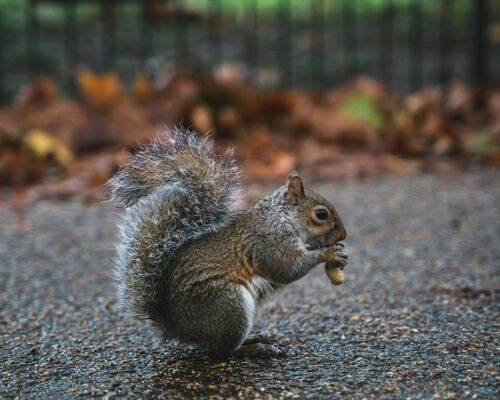
A Squirrel Stops to Eat on a Park Path – Photo by Connor Danylenko
One of the most significant ways urban wildlife supports tree care is through natural planting and reforestation. This process, known as zoochory , is a key factor in maintaining and expanding urban forests.
The Squirrel Effect
Squirrels are nature’s most enthusiastic tree planters, playing a crucial role in forest regeneration:
- They bury thousands of seeds and nuts every year, many of which they will forget.
- These forgotten caches often sprout, leading to new tree growth.
- Squirrels prefer certain tree species, influencing forest composition over time.
- Their caching behavior helps seeds survive through winter and protects them from other seed predators.
- Squirrels’ digging activities can also help mix soil layers, improving conditions for seed germination.
Avian Arborists
Birds also play a crucial role in tree planting, often dispersing seeds over longer distances than mammals:
- Many bird species eat fruits and berries, dispersing seeds through their droppings.
- Jays and crows are known to cache seeds similarly to squirrels.
- Some birds, like woodpeckers, create cavities that later serve as planting sites for wind-dispersed seeds.
- Migratory birds can transport seeds over long distances, introducing new species to urban areas.
- Birds’ droppings often contain nutrients that can help fertilize the soil around newly sprouted seeds.
Impact on Urban Forest Diversity
Wildlife-driven planting has a significant impact on urban tree diversity:
- Animals often spread seeds further than wind or water alone.
- Different species prefer different types of seeds, ensuring a mix of tree species.
- This natural planting helps create resilient, diverse urban forests better equipped to handle climate change and disease.
- Wildlife-planted trees often grow in locations that might be overlooked by human planters, filling in gaps in the urban canopy.
- The random nature of animal-dispersed seeds can lead to more natural-looking, less uniform urban forests.
Pest Control: Urban Wildlife as Nature’s Tree Doctors
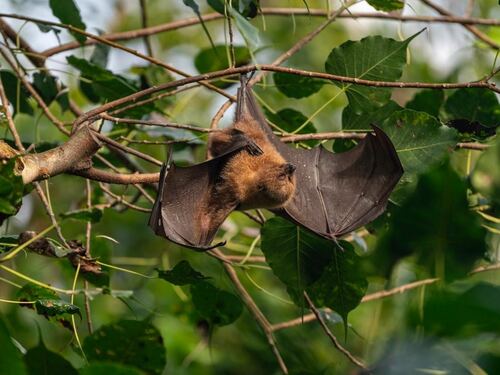
A Bat Dangles from a Leafy Branch – Photo by Fabian Kessler
Urban wildlife serves as a natural, eco-friendly pest control system for our city trees. This biological control helps maintain tree health without the need for chemical interventions.
Birds: The Aerial Pest Control Squad
Many bird species are voracious insect eaters, providing a first line of defense against tree pests:
- A single chickadee can eat up to six thousand insects in one year.
- Woodpeckers specifically target wood-boring insects that can harm trees.
- Larger birds like owls help control rodent populations that might damage young trees.
- Insectivorous birds can quickly respond to pest outbreaks, helping to prevent widespread damage.
- Some birds, like cuckoos, specialize in eating hairy caterpillars that other birds avoid, providing targeted pest control.
Bats: Nighttime Pest Patrol
Bats are often overlooked contributors to urban tree health:
- A single bat can consume up to one thousand mosquito-sized insects per hour.
- They help control night-flying insects that birds miss during the day.
- Some bat species also pollinate trees and disperse seeds.
Small Mammals: Ground-Level Guardians
Rodents and other small mammals play a role in pest control too:
- Many eat insects and their larvae, keeping pest populations in check.
- Some, like shrews, eat slugs and snails that can damage young trees.
- Their foraging activities can disrupt the life cycles of soil-dwelling pests.
- Even “nuisance” animals like raccoons can help by eating grubs and other lawn pests that might affect tree roots.
- The burrowing activities of some mammals can help aerate soil and improve drainage around trees.
Natural vs. Chemical Pest Control
Wildlife-based pest control offers several advantages over chemical methods:
- It’s sustainable and self-regulating.
- There’s no risk of chemical runoff or unintended environmental impacts.
- It supports overall biodiversity in urban ecosystems.
- Wildlife pest control is often more cost-effective in the long term compared to repeated chemical treatments.
- Natural pest control can reach areas that might be difficult or dangerous for human intervention, such as high in tree canopies.
Pollinators: The Lifeblood of Urban Tree Reproduction
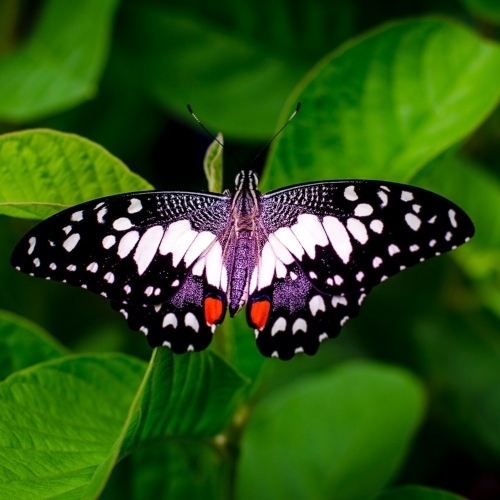
A Spotted Butterfly on a Leaf – Image by Zett Foto
Pollinators are essential for the reproduction of many tree species, ensuring genetic diversity and long-term forest health. Their role in urban ecosystems cannot be overstated.
The Buzz About Bees
Bees are perhaps the most well-known pollinators:
- They pollinate a wide variety of tree species, from fruit trees to hardwoods.
- Native bee species are often more efficient pollinators than honeybees for local tree species.
- Urban beekeeping can support both tree health and local honey production.
- Bees’ pollination services improve fruit yield and quality in urban orchards and gardens.
- Different bee species are active at different times of the day and season, providing comprehensive pollination coverage.
Butterflies and Moths: The Overlooked Pollinators
These insects play a significant role in tree pollination, often complementing the work of bees:
- Many are active at different times than bees, extending the pollination period.
- Some specialize in pollinating specific tree species.
- Their larvae (caterpillars) also play a role in ecosystem balance.
- Some moth species are particularly important for night-blooming trees.
- Butterflies and moths can travel long distances, helping to cross-pollinate trees in different parts of the city.
Enhancing Pollinator Habitats in Cities
To support these crucial tree care workers, cities can:
- Plant diverse, native flowering species alongside trees
- Reduce pesticide use in urban green spaces
- Create pollinator corridors to connect fragmented habitats
Nutrient Cycling: Wildlife’s Role in Soil Health for Trees
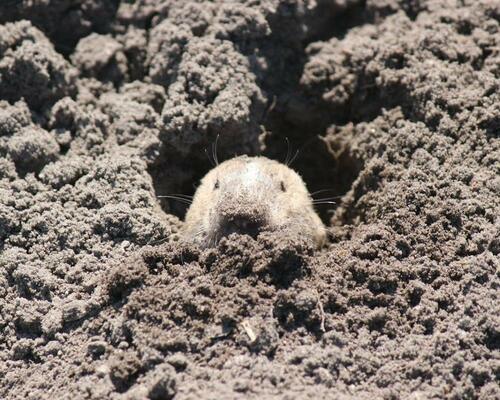
A Gopher Peeks Out from its Tunnel – Photo by Reagan Ross
Healthy soil is crucial for tree growth, and urban wildlife plays a key role in maintaining soil quality.
The Power of Poop
Animal droppings contribute significantly to soil health:
- They add essential nutrients like nitrogen and phosphorus.
- Droppings can help improve soil structure and water retention.
- Some animals, like certain bird species, transport nutrients from aquatic to terrestrial ecosystems.
Soil Aeration and Water Penetration
Burrowing animals improve soil conditions for trees:
- Their tunnels increase soil aeration , benefiting tree roots.
- These tunnels also improve water penetration, reducing runoff and erosion.
- Earthworms, while often introduced in urban areas, play a crucial role in soil health.
Leaf Litter Management
Many urban animals help process fallen leaves, contributing to nutrient cycling:
- Insects and small mammals break down leaf litter, returning nutrients to the soil.
- This process helps prevent leaf buildup, which can smother grass and young plants.
- Decomposition of leaf litter also supports a wide range of soil microorganisms that are beneficial to trees.
Challenges and Solutions in Urban Wildlife-Tree Care Dynamics
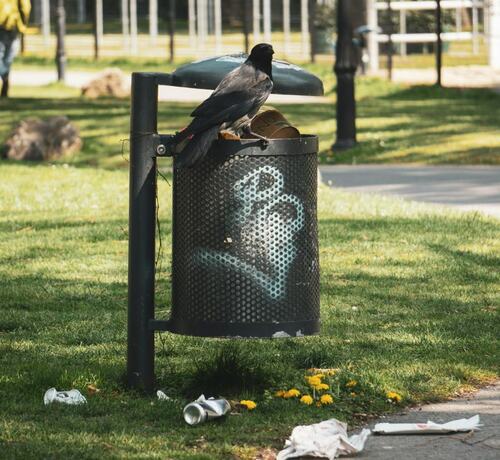
A Large Bird Rummages Through Trash – Photo by Seri on Unsplash
While urban wildlife provides many benefits to trees, there are also challenges in managing this relationship. Balancing the needs of wildlife, trees, and human residents requires thoughtful planning and management.
Balancing Human and Wildlife Needs
Urban planners face several challenges:
- Ensuring sufficient green space for both wildlife and human recreation
- Managing “nuisance” wildlife that may damage property or create safety concerns
- Educating the public about the benefits of urban wildlife to increase tolerance and support
Mitigating Wildlife-Human Conflicts
Several strategies can help reduce conflicts:
- Implementing wildlife-friendly waste management to reduce attraction to human food sources
- Using tree guards to protect young trees from damage by deer or rodents
- Designating parks and green spaces to provide sufficient habitat while maintaining human-use areas
Innovative Urban Planning Strategies
Cities are finding creative ways to support both trees and wildlife:
- Creating wildlife corridors to connect fragmented habitats
- Incorporating diverse native plant species into landscaping to support local wildlife
- Implementing Dark Sky Initiatives to reduce light pollution, benefiting nocturnal species
Educational Initiatives
Public education is key to fostering coexistence, including:
- Offering urban wildlife workshops to residents
- Creating interpretive signage in parks in parks to highlight wildlife-tree interactions
- Developing school programs to teach children about urban ecology
Conclusion
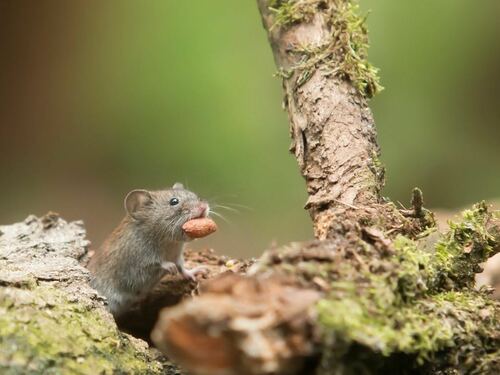
A Mouse Eating at the Base of a Tree – Photo by Monique Laats
Urban wildlife species are the unsung heroes of tree care in our cities, playing indispensable roles in maintaining healthy urban forests. By recognizing and supporting the vital connection between wildlife and trees, we can create greener, more vibrant cities for all inhabitants. As we continue to expand our urban areas, it’s crucial to design and manage spaces with both trees and wildlife in mind, enhancing the quality of life for city dwellers through more resilient, biodiverse, and beautiful urban environments.
For expert advice on supporting urban wildlife and maintaining healthy trees in your area, contact Arborist Now . Together, we can build cities where nature and urban life coexist in harmony, creating a sustainable future for generations to come.


